This article was medically reviewed by Theodore Leng, MD. Dr. Leng is a board certified Ophthalmologist and Vitreoretinal Surgeon and an Assistant Professor of Ophthalmology at Stanford University. He completed his MD and Vitreoretinal Surgical Fellowship at Stanford University in 2010. Dr. Leng is a Fellow of the American Academy of Ophthalmology and the American College of Surgeons. He is also a member of the Association for Research in Vision and Ophthalmology, the Retina Society, the Macula Society, the Vit-Buckle Society, as well as the American Society of Retina Specialists. He received the Honor Award by the American Society of Retina Specialists in 2019.
There are 21 references cited in this article, which can be found at the bottom of the page.
wikiHow marks an article as reader-approved once it receives enough positive feedback. In this case, 100% of readers who voted found the article helpful, earning it our reader-approved status.
This article has been viewed 153,275 times.
Experts agree that foreign bodies like contact lenses, fingernails, dust, dirt, sand, wood particles, and metal bits can all scratch your cornea.[1] Your cornea is the transparent protective window that covers the front of your eye. Symptoms of a scratched cornea include irritation, eye watering, redness, sensitivity to light, and feeling like something is in your eye. Researchers say a scratched cornea may improve in as little as 24 to 48 hours with treatment, but your symptoms may last longer if the scratch is deep.[2] If you suspect you have a scratched cornea, it's best to visit your eye doctor to see if you need medical treatment.
Steps
Removing Foreign Objects
-
1Try blinking. Sometimes scratches to the cornea are caused by small objects that get trapped beneath the eyelid, such as dust, dirt, sand or even an eyelash. Before you can start to treat the scratch, you must remove this foreign object. Try blinking several times in a row to remove the object. Closing and opening your eye can stimulate the lacrimal glands to produce more tears and wash the foreign body out of the eye.[3]
- With your right hand, pull the upper eyelid over the lower eyelid of the affected eye. The lashes of the lower eyelid may brush the foreign object out of the eye.
- Do not try to remove any trapped items with your fingers, tweezers, or any other object as this can make the eye injury worse.
-
2Rinse out your eye. If blinking didn't get the foreign object out of your eye, try rinsing your eye with water or saline solution. It's best to use a sterile or saline solution. Do not use tap water. Ideal properties for eyewash solution include a neutral pH of 7.0 and a temperature between 60°F and 100°F (15.5 to 37.8°C). Though this is anecdotally often suggested, do NOT administer the solution to your eye using a cup. If there is a foreign object in the eye, using a cup to pour water on it can cause the object to become further lodged in the eye. Follow these guidelines as to how long you should rinse your eye out:[4]
- For mildly irritating chemicals, rinse for five minutes.
- For moderate-to-severe irritants, rinse for at least 20 minutes.
- For non-penetrating corrosives such as acids, rinse for 20 minutes.
- For penetrating corrosives such as alkalis, rinse for at least 60 minutes.
- Be sure to note any additional symptoms that may indicate that a poisonous solution has gotten into the eye, including: nausea or vomiting, headaches or lightheadedness, double vision or impaired vision, dizziness or loss of consciousness, rashes or fever. If you notice these symptoms, call poison control (800) 222-1222 and seek medical attention immediately.
Advertisement -
3Use eye drops. Another method of removing any trapped objects is to place some lubricating eye drops in the injured eye to flush it out. Lubricating eye drops can be purchased over-the-counter at the drugstore. You can put the eye drops in yourself or get someone else to help you. The correct method for using eye drops is described in Part 3 below.[5]
- Artificial tear drops are designed to lubricate eyes and keep them moist on the outer surface. They are available over the counter and are available in a wide assortment of brands. Some artificial tears contain preservatives to help keep the solution on the surface of your eyes for a longer period of time. However, these preservatives can irritate your eyes if you use them more than four times per day. If you need to use artificial tears more than four times per day, look for preservative-free artificial tears.[6]
- Hydroxypropyl methylcellulose and carboxymethylcellulose are the two most common lubricants in tear drops and can be found in many over-the-counter-solutions.
- Trial and error is usually the only way to find the best brand of artificial tears for your particular eyes. In some cases, a combination of a few brands may be even be necessary. In the case of chronic dry eyes, artificial tears must be used even if the eyes are symptom-free. Artificial tears can only provide supplemental care and are not a substitute for natural tears.
-
4See your doctor if the scratch worsens and doesn't heal. Once the foreign object has been removed, a lightly scratched cornea should heal on its own in a number of days. However, serious scratches or those that have become infected will require antibacterial eye drops in order to heal properly. See your doctor if any of the following occurs:[7]
- You suspect that the foreign object is still in your eye.
- You experience any combination of the following symptoms: blurry vision, redness, substantial pain, tearing, extreme light sensitivity.
- You think you have a corneal ulceration (open wound on your cornea), which is usually caused by an infection in the eye.
- You have green, yellow or bloody pus coming out of your eye.
- You notice light flashes or you visualize tiny dark objects or shadows floating around.
- You have a fever.
Letting Your Eye Heal
-
1Get a diagnosis. If you suspect you have injured your cornea, it's best to make an appointment with your eye doctor.[8] The doctor will use a penlight or ophthalmoscope to examine your eye for trauma. Your doctor may also examine your injured eye using special eye drops with Fluorescein dye that make your tears yellow. This dye helps make your abrasion more visible under the blue light.[9]
- To do this, a topical anesthetic is added to the eye and then your lower lid will be pulled down gently. A Fluorescein strip is then touched onto the eye, and as you blink, the dye spreads throughout the eye. Yellow stained areas under normal light indicated damaged corneal areas. Your doctor will then use a special cobalt blue light to highlight areas of abrasion and to determine the cause.[10]
- Several vertical abrasions can indicate a foreign body, while branching stains can indicate herpes keratitis. Additionally, several punctuated lesions can indicate your contact lens as a cause.[11]
- Your vision will be affected by this dye and you will see a yellow haze for a few minutes. You may also experience a yellow discharge from your nose during this time.
-
2Take oral pain medication to alleviate pain. If your scratched cornea is causing you pain, it's a good idea to take over-the-counter pain medications, such as those containing acetaminophen (Tylenol).[12]
-
3Avoid wearing an eye patch. Eye patches were traditionally used to help heal a corneal scratch, however recent medical studies have found that eye patches can actually increase pain and prolong healing. An eye patch hinders the natural blinking of the eye, thus straining the eyelids and producing pain. It also increases the tearing of the eye and this invites more infection and delays the healing process. [15]
- An eye patch also decreases oxygen delivery, and the cornea is dependent on oxygenation.[16]
-
4Inquire about alternatives to eye patches. Nowadays, instead of an eye patch, your doctor will often prescribe nonsteroidal anti-inflammatory (NSAID) eye drops, used in combination with a soft, disposable contact lens. The eye drops are designed to decrease the sensitivity of your cornea. The soft contact lens is used as a bandage to protect your eye, speed up the healing process and reduce pain while it heals. Unlike with eye patches, this therapy allows you to see out of both of your eyes, all the while reducing inflammation. The most common prescribed eye drops and ointments include topical NSAIDs[17] and antibiotics.[18]
- Topical NSAIDs: Try Diclofenac (Voltaren), 0.1% solution. Put one drop in your eye four times daily. You can also try Ketorolac (Acular), 0.5% solution. Use one drop four times daily.See Part 3 for how to administer eye drops.Always follow the instructions and dosage outlined on the packaging.
- Topical antibiotics: Try Bacitracin (AK-Tracin) and use 1/2-inch ribbon two to four times daily. Or use erythromycin ophthalmic ointment, applying a 1/2-inch ribbon. You can also use Chloramphenicol (Chloroptic), 1% ointment and give yourself two drops every three hours. Yet another option is Ciprofloxacin (Ciloxan), 0.3% solution, where the dosage changes over the course of the treatment. On the first day, administer two drops every 15 minutes for six hours, then two drops every 30 minutes for rest of day. On the second day, administer two drops per hour. From the third day to day 14, administer two drops every four hours. Always follow the instructions and dosage outlined on the packaging.
-
5Don't wear any eye makeup. Wearing eye makeup — such as mascara, eye shadow or eyeliner — can irritate the injured eye and prolong healing. Therefore, it's best to avoid wearing eye makeup until the scratch has completely healed.[19]
-
6Wear sunglasses. It's a good idea to wear sunglasses while you're dealing with a scratched cornea to protect your eyes from light sensitivity. Sometimes a scratched cornea will cause light sensitivity. You can protect your eyes from the light by wearing sunglasses with UV protection, even while indoors.[20]
- If you are experiencing extreme sensitivity to light or spasms in your eyelid, your ophthalmologist may choose to give you eye drops designed to dilate your pupil. This helps to reduce pain and relax your eye muscles. See Part 3 on how to administer pupil dilating eye drops.
-
7Don't wear contact lenses. Avoid wearing your contacts until your physician says it's safe. If you wear contacts regularly, it's recommended that you avoid wearing them for at least a week following the injury, until your cornea has healed completely.[21]
- This is particularly important if the cornea scratch was caused by wearing contact lenses in the first place.
- You should also not wear contact lenses while applying antibiotic treatments to your injured cornea. Wait 24 hours after your last dosage of antibiotics before wearing them again.[22]
Using Eye Drops
-
1Wash your hands. Give your hands a thorough wash with antibacterial soap before putting in the eye drops. It is very important that you avoid introducing bacteria to the injured eye, otherwise you could cause an infection.[23]
-
2Open the bottle of eye drops. Once open, discard the first bead of liquid. This is done to prevent any dirt or residue at the top of the dropper from coming in contact with the eye.
-
3Tilt your head back and hold a tissue beneath your injured eye. The tissue will soak up any excess liquid that escapes from the eye. It's best to tilt your head backwards order to allow gravity to do its work and help the drop soak into the eye, rather than just drip out of it.[24]
- You can administer eye drops while standing, sitting or lying down as long as your head is back.
-
4Insert the eye drops. Look up and use the index finger of your non-dominant hand to pull down the lower eyelid of your injured eye. Squirt the eye drops into the lower lid.[25]
- As to how many drops you should squirt into your eye, follow the directions on the bottle or your physician's advice. Do not exceed the recommended dosage.
- Wait a few minutes between drops if you need to put in more than one to make sure that the first drop gets absorbed and is not washed out by the second.
- Make sure the tip of the dropper does not make any direct contact with your eyeball, eyelid or eyelash, as this can introduce foreign bacteria into the eye.
-
5Close your eye. Once the drops are in, gently close your eye and keep it shut for 30 seconds. You could even keep your eyes closed for up to two minutes. This allows the eyedrop solution to spread across the eyelid and prevents it from leaking out of the eye.[26]
- Just make sure not to squeeze the eye too tightly, as this can squeeze the ointment out and cause injury to the eye.
-
6Blot around your eye. Using a soft cloth or tissue, gently blot around your eye to remove any excess solution.[27]
Preventing a Scratched Cornea
-
1Wear protective goggles during specific activities. Unfortunately, once you have scratched your cornea once, you are more likely to injure it again. Therefore it's important to take certain preventative measures to protect your eyes from foreign objects and injury.[28] For example, studies have shown that wearing protective eyewear can reduce the risk of getting an eye injury at your work by more than 90%.[29] Consider wearing protective goggles (or at least glasses) during the following activities:[30]
- Playing sports such as softball, paintball, lacrosse, hockey and racquetball.
- Working with chemicals, power tools or anything that can splatter into your eyes.
- Mowing the lawn and weed-whacking.
- Riding in a convertible, on a motorcycle or bicycle.
-
2Avoid wearing contact lenses for long periods of time. Wearing contact lenses for long periods of time can cause your eyes to dry out, making them more prone to injury. Therefore you should only wear your contact lenses for the specific amount of time recommended by your ophthalmologist.[31]
- Try to plan out your day so that you are not stuck wearing your contacts all day. For example, if you run in the morning and know you want to go for a bike ride in the evening, wear your glasses all day in between those activities when working at your computer. Make a concerted effort to bring your glasses with you and change into them where appropriate.
-
3Use artificial tears to keep your eyes lubricated. Use a product like artificial tears to lubricate your eyes even after your scratch has healed. Not only does this lubricate your eyes, but it also helps to flush out foreign objects (such as an eyelash) before they can scratch your cornea.
Warnings
- A deeper scratch will require professional treatment and may scar your cornea, which will permanently affect your vision. In a case such as this, you may even need a corneal transplant.⧼thumbs_response⧽
References
- ↑ https://familydoctor.org/condition/corneal-abrasions/
- ↑ https://www.health.harvard.edu/a_to_z/corneal-abrasion-a-to-z
- ↑ http://www.aoa.org/patients-and-public/eye-and-vision-problems/glossary-of-eye-and-vision-conditions/dry-eye?sso=y
- ↑ https://www.aao.org/eye-health/tips-prevention/first-aid-eye-scratches
- ↑ https://my.clevelandclinic.org/health/diseases/14423-corneal-abrasion
- ↑ https://www.aao.org/eye-health/treatments/lubricating-eye-drops
- ↑ https://myhealth.alberta.ca/Health/Pages/conditions.aspx?hwid=sig57269&lang=en-ca
- ↑ http://patient.info/health/corneal-injury-and-foreign-bodies
- ↑ http://www.aafp.org/afp/2013/0115/p114.html
- ↑ http://www.aafp.org/afp/2013/0115/p114.html
- ↑ http://www.aafp.org/afp/2013/0115/p114.html
- ↑ https://myhealth.alberta.ca/Health/aftercareinformation/pages/conditions.aspx?hwid=uh3288
- ↑ http://www.aafp.org/afp/2013/0115/p114.html
- ↑ https://mft.nhs.uk/app/uploads/sites/2/2018/04/REH-201.pdf
- ↑ http://www.ncbi.nlm.nih.gov/pubmedhealth/PMH0072767/
- ↑ https://www.aafp.org/pubs/afp/issues/2004/0701/p123.html
- ↑ https://www.aao.org/eye-health/treatments/pain-relieving-eye-drops
- ↑ https://www.aao.org/eye-health/treatments/antibiotic-eye-drops
- ↑ https://www.drugs.com/health-guide/corneal-abrasion.html
- ↑ https://www.aao.org/eye-health/diseases/what-is-corneal-abrasion
- ↑ http://patient.info/health/corneal-injury-and-foreign-bodies
- ↑ http://patient.info/health/corneal-injury-and-foreign-bodies
- ↑ https://www.nei.nih.gov/learn-about-eye-health/eye-conditions-and-diseases/glaucoma/glaucoma-medicines/how-put-eye-drops
- ↑ https://www.aao.org/eye-health/treatments/how-to-put-in-eye-drops
- ↑ http://www.glaucoma.org/treatment/eyedrop-tips.php
- ↑ https://www.nei.nih.gov/learn-about-eye-health/eye-conditions-and-diseases/glaucoma/glaucoma-medicines/how-put-eye-drops
- ↑ https://www.aao.org/eye-health/treatments/how-to-put-in-eye-drops
- ↑ http://www.stlukes-stl.com/health-content/health-ency-multimedia/1/001017.htm
- ↑ https://www.drugs.com/health-guide/corneal-abrasion.html
- ↑ http://patient.info/health/corneal-injury-and-foreign-bodies
- ↑ https://www.drugs.com/health-guide/corneal-abrasion.html
- ↑ http://patient.info/health/corneal-injury-and-foreign-bodies
About This Article
Scratched corneas can be painful and inconvenient, but if you’re patient and take time to let yourself heal, you’ll be feeling better soon. If you think your cornea is scratched, see your eye doctor as soon as possible for treatment. They’ll likely put a dye into your eye to locate the area that’s scratched. Then, they may prescribe anti-inflammatory eye drops or soft contact lenses to protect your eye while it heals. If you're in a lot of pain, take an over-the-counter pain reliever while you recover. Avoid using a patch or anything else that totally covers your scratched eye, since these can actually slow down your recovery. Wear sunglasses instead to protect your eye when you go outside. To learn how to prevent getting cornea scratches in the future, read more from our Optometry co-author.
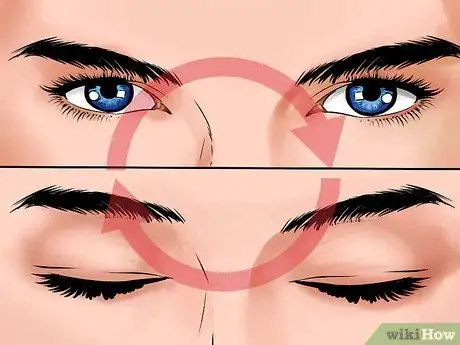
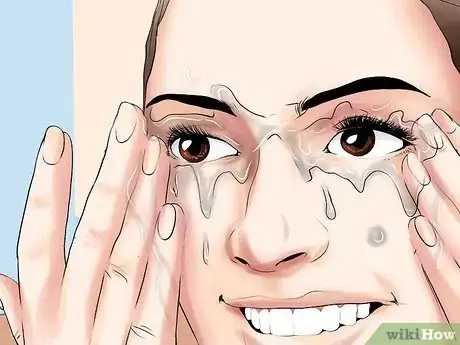
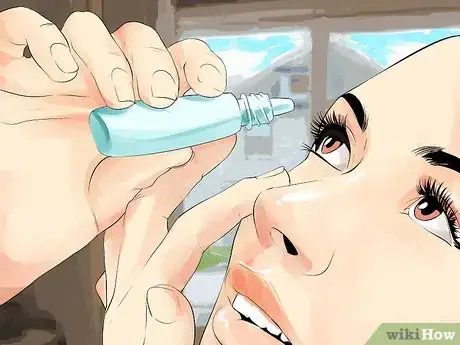


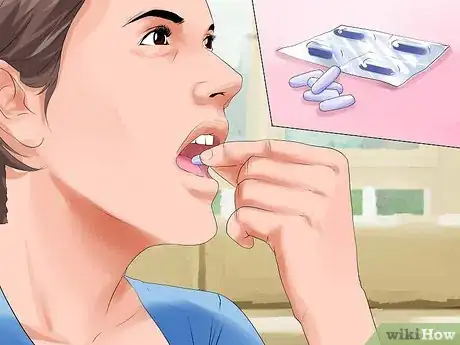
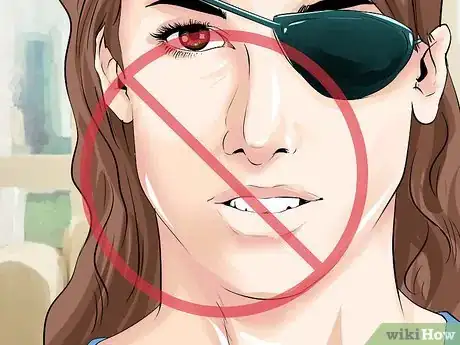
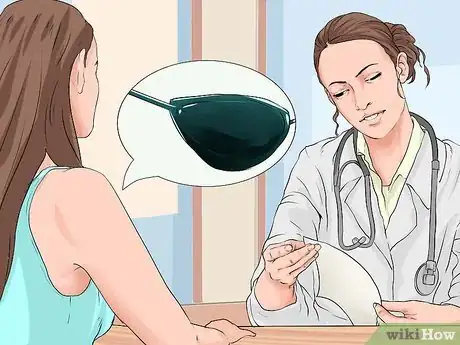
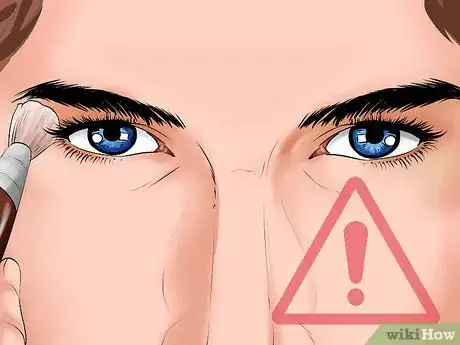

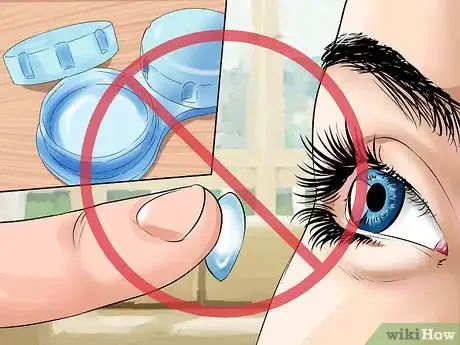
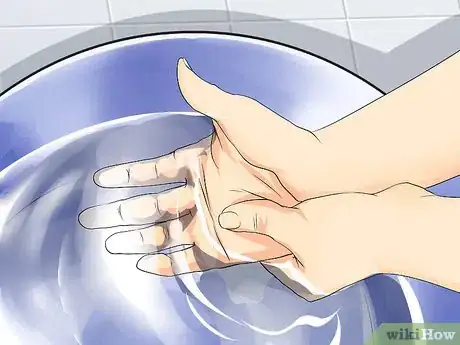
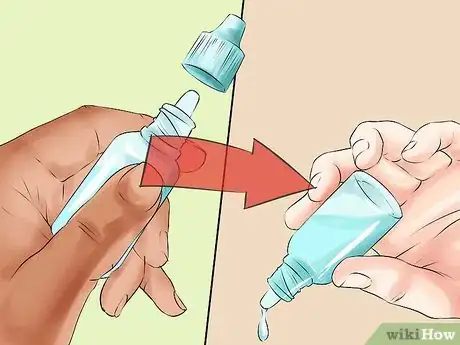
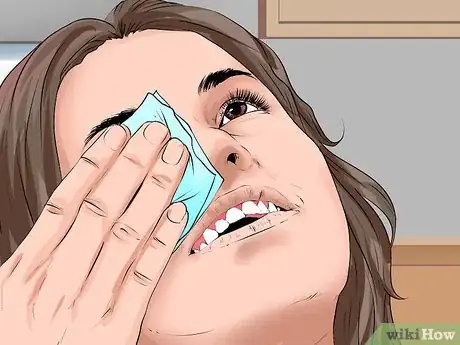
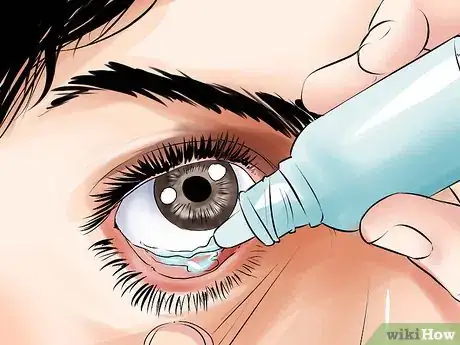
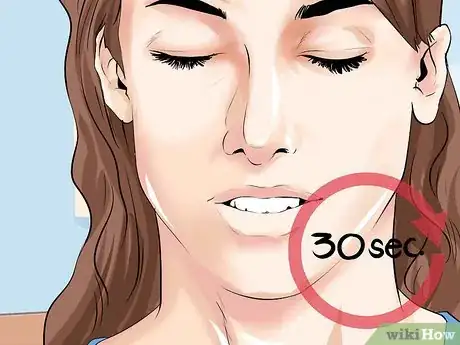
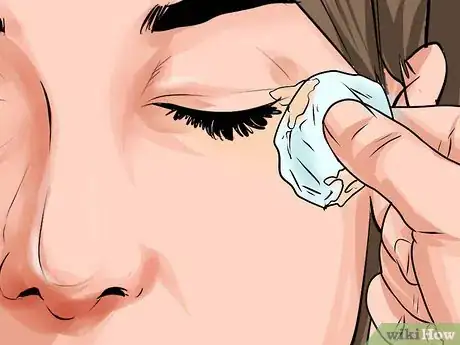

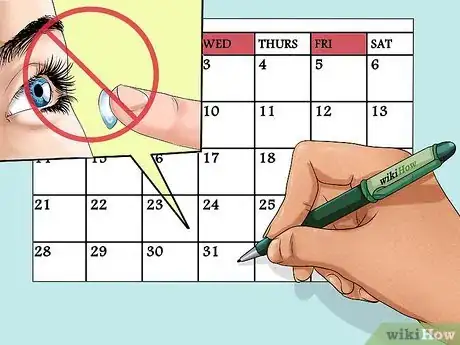



-Step-3-Version-2.webp)


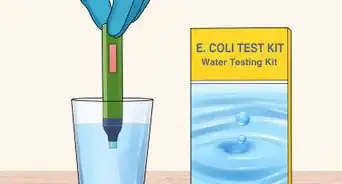















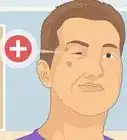

-Step-3-Version-2.webp)



































Medical Disclaimer
The content of this article is not intended to be a substitute for professional medical advice, examination, diagnosis, or treatment. You should always contact your doctor or other qualified healthcare professional before starting, changing, or stopping any kind of health treatment.
Read More...